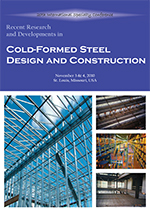Session Dates
03 Nov 2010
Abstract
The Direct Strength Method (DSM) rece ntly included in the North American Specification and Australian/New Zealand Standard AS/NZS 4600:2005 gives design rules for compression and bending. No rules are presente d at this stage for shear. Two series of tests on C-section can be used to develop and calibrate rules for design in shear. These are the University of Missouri Rolla tests of the 1970’s and recent tests on high strength C-sections at the University of Sydney. Both series of tests use a similar test rig altho ugh different levels of tension field action have been observed. Two features research ed are the effect of full section shear buckling (as opposed to web only shear buckling), and tension field action. Full section buckling is a feature of the DSM bu t requires software that can evaluate full sections for shear. The paper proposes DSM design rules for C-sections in shear both with and without tension field action. Both series of test results are compared with the pro posed design rules.
Department(s)
Civil, Architectural and Environmental Engineering
Research Center/Lab(s)
Wei-Wen Yu Center for Cold-Formed Steel Structures
Meeting Name
20th International Specialty Conference on Cold-Formed Steel Structures
Publisher
Missouri University of Science and Technology
Document Version
Final Version
Rights
© 2010 Missouri University of Science and Technology, All rights reserved.
Document Type
Article - Conference proceedings
File Type
text
Language
English
Recommended Citation
Pham, Cao Hung and Hancock, Gregory J., "Direct Strength Design of Cold-formed C-sections for Shear" (2010). CCFSS Proceedings of International Specialty Conference on Cold-Formed Steel Structures (1971 - 2018). 1.
https://scholarsmine.mst.edu/isccss/20iccfss/20iccfss-session5/1
Direct Strength Design of Cold-formed C-sections for Shear
The Direct Strength Method (DSM) rece ntly included in the North American Specification and Australian/New Zealand Standard AS/NZS 4600:2005 gives design rules for compression and bending. No rules are presente d at this stage for shear. Two series of tests on C-section can be used to develop and calibrate rules for design in shear. These are the University of Missouri Rolla tests of the 1970’s and recent tests on high strength C-sections at the University of Sydney. Both series of tests use a similar test rig altho ugh different levels of tension field action have been observed. Two features research ed are the effect of full section shear buckling (as opposed to web only shear buckling), and tension field action. Full section buckling is a feature of the DSM bu t requires software that can evaluate full sections for shear. The paper proposes DSM design rules for C-sections in shear both with and without tension field action. Both series of test results are compared with the pro posed design rules.



